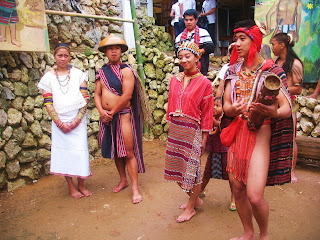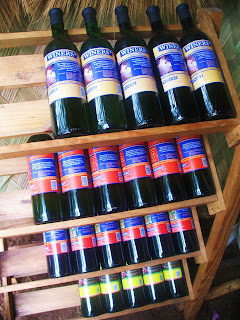The Tam-awan Village, which has a beautiful
view of Pinsao and the mountains beyond, is a popular art space in Baguio and
favorite tourist destination. It annually holds the Tam-awan International Arts
Festival
Traditional Cordilleran culture, exotic wines, tattoo art, comics and art conservation, among others, were featured in the third Tam-awan International Arts Festival from May 23 to 27 in Baguio City. Every year, the festival presents an eclectic mix of subjects and interests in arts and culture — from “high-brow” to pedestrian, from traditional to contemporary, from indigenous to foreign — in lectures, workshops, performances, exhibits and other activities.
Every day of the festival, a canao ritual is performed, in which
a pig is slaughtered and its meat cooked and shared by the community
The Schools of Living Traditions (SLT) Corner was formally opened
showcasing products from SLTs conducted in Benguet
Native attires of different ethnic groups of the Cordillera accompanied
the lecture of Sonia Daoas
The traditional clothes of the Isneg of Apayao
The Tam-awan Village has been a favorite stop for visitors of Baguio City, the Philippines’ summer capital because of its favorable cool climate, tourist destination and the Cordillera region’s educational capital. The city draws a mix of tourists and excursionists, and students from all over the country, mixing with locals as well as indigenous peoples from other parts of the Cordilleran region. It has also attracted artists, creating a vibrant community of artists. Tam-awan Village is one venue where artists, both local and from other places, find space for their art.
Chanum Foundation, founded in 1998, initially aimed to recreate a cluster of traditional Cordilleran huts for visitors. Tam-awan Village grew to become an art venue that promotes Cordilleran culture and art in general. Tam-awan means “viewpoint” because of its location — on the mountainside with a view of the barangay proper of Pinsao and the mountains beyond.
The village provides accommodations in its Ifugao huts. It also has art gallery, venues for seminars and workshops, a souvenir shop, a coffee shop, gardens, nature trails, a pond and view decks. Installations, paintings and sculpture litter the place. Tam-awan also conducts arts and crafts workshops, as well as holds cultural shows. An arts festival is but an apt endeavor in its mission of promoting and fostering arts and culture. Since the beginning, the National Commission for Culture and the Arts (NCCA), the government agency for arts and culture, has been partly sponsoring the event.
NCCA executive director Emelita Almosara led the opening ceremony of the festival together with Benguet Gov. Nestor Fongwan, Rafael Tallocoy of the Baguio City Mayor’s Office and Chanum Foundation president Jordan Mang-osan. They were joined by comic book artist Danny Acuna and EJ Jacinto of the Philippine Arts Education Association for the press conference and dialog that followed, where issues concerning arts and culture were tackled.
Each day, a cañao was performed, a Cordilleran ritual asking for blessings. A pig was butchered at the dap-ay, a gathering place paved with stones, and the meat cooked and shared by the participants.
The first day of the festival saw the opening of the Schools of Living Traditions (SLT) Corner in the village. The SLT is a project of the NCCA, which enables the transfer of traditions such as weaving, music, dances, crafts and others from the masters to the younger generation in indigenous communities all over the country. The NCCA has funded many SLTs around the province of Benguet, and the SLT Corner aims to showcase the products from these SLTs. Traditional items from Atok, Bakun, Bokod, Buguias, Itogon, Kabayan, Kapangan, Kibungan, La Trinidad, Mankayan, Sablan, Tuba and Tublay are on sale in the hope to establish a creative industry.
With this year’s theme “Brewing with Art,” the center piece of the festival was the different wines that use local crops. Several booths were set up around the village featuring winemakers from the Cordilleran provinces of Mountain Province, Ifugao and Benguet, Ilocos Sur from the neighboring Ilocos Region, and also from Germany. The wines were made from an intoxicating and exciting variety of fruits and roots crops — tomato, sweet potato, coffee, sugar cane, Java plum, rice, strawberry, guava, pomelo, honeydew melon, lemon, sour sop, pineapple, carrot, etc.
Chanum Foundation, founded in 1998, initially aimed to recreate a cluster of traditional Cordilleran huts for visitors. Tam-awan Village grew to become an art venue that promotes Cordilleran culture and art in general. Tam-awan means “viewpoint” because of its location — on the mountainside with a view of the barangay proper of Pinsao and the mountains beyond.
The village provides accommodations in its Ifugao huts. It also has art gallery, venues for seminars and workshops, a souvenir shop, a coffee shop, gardens, nature trails, a pond and view decks. Installations, paintings and sculpture litter the place. Tam-awan also conducts arts and crafts workshops, as well as holds cultural shows. An arts festival is but an apt endeavor in its mission of promoting and fostering arts and culture. Since the beginning, the National Commission for Culture and the Arts (NCCA), the government agency for arts and culture, has been partly sponsoring the event.
NCCA executive director Emelita Almosara led the opening ceremony of the festival together with Benguet Gov. Nestor Fongwan, Rafael Tallocoy of the Baguio City Mayor’s Office and Chanum Foundation president Jordan Mang-osan. They were joined by comic book artist Danny Acuna and EJ Jacinto of the Philippine Arts Education Association for the press conference and dialog that followed, where issues concerning arts and culture were tackled.
Each day, a cañao was performed, a Cordilleran ritual asking for blessings. A pig was butchered at the dap-ay, a gathering place paved with stones, and the meat cooked and shared by the participants.
The first day of the festival saw the opening of the Schools of Living Traditions (SLT) Corner in the village. The SLT is a project of the NCCA, which enables the transfer of traditions such as weaving, music, dances, crafts and others from the masters to the younger generation in indigenous communities all over the country. The NCCA has funded many SLTs around the province of Benguet, and the SLT Corner aims to showcase the products from these SLTs. Traditional items from Atok, Bakun, Bokod, Buguias, Itogon, Kabayan, Kapangan, Kibungan, La Trinidad, Mankayan, Sablan, Tuba and Tublay are on sale in the hope to establish a creative industry.
With this year’s theme “Brewing with Art,” the center piece of the festival was the different wines that use local crops. Several booths were set up around the village featuring winemakers from the Cordilleran provinces of Mountain Province, Ifugao and Benguet, Ilocos Sur from the neighboring Ilocos Region, and also from Germany. The wines were made from an intoxicating and exciting variety of fruits and roots crops — tomato, sweet potato, coffee, sugar cane, Java plum, rice, strawberry, guava, pomelo, honeydew melon, lemon, sour sop, pineapple, carrot, etc.
Wines from Phoenix Wines and Distillery of La Trinidad, Benguet
Locally made wines made from exotic fruits take center stage in this
year’s festival
Wines made from sweet potato, carrot and tomatillo
Featured winemakers included Manuel Gayagay Gayao, who makes local rice wine called tapuey from Sagada, Mountain Province; Carlos Espejo and Michael Nisola from Ilocos Sur, who make basi, the Ilocano sugar cane wine; Noemi Pentiano Soriano and Eleanor Rosario from Abatan, Buguias, Benguet, who make camote wine, among others; Gary Bantali from Bad-ayan, Buguias, Benguet, who makes camote, carrot and tomatillos wines; Benicio Sokkong from Kalinga and Delfin Eyan Sallidao from La Trinidad, Benguet, who make sugar cane wine; and Zelmir Struga from Germany who makes scnaps from fruits.
During the day, workshops, lectures and talks were conducted. A two-day workshop on Cordilleran music and dances was facilitated by Sokkong, a composer, instrument maker and singer from Kalinga, and Mary Ann Bungaoen, a cultural worker from Kalinga. Beatrix Angeles from the NCCA Legal Office gave a talk on intellectual property rights, while Dr. Reuben Canete delved on art curatorship and conservation. Curator Kenneth Esguerra talked about museum restoration. Chinese-Filipino medical doctor and researcher Charles Cheng discussed Chinese art and culture, while anthropology professor Analyn Salvador-Amores talked about tattoo art. Veteran comic illustrator Danny Acuña gave a lecture on comic book history. Educator and media worker Sonia Daoas lectured on the traditional clothing and ornaments of the different ethnic groups of the Cordillera region, espousing the recreation of items which are no longer being made. Her talk was accompanied by live demonstrations.
During nights, there were performances by the workshop participants; of a performance art by Tam-awan resident artist John Frank Sabado; the Wangal Ivadoi Performing Arts group; of Ghanaian, Korean and Indian dances from the International Students Association of the University of Baguio; by the Pangalay Artists’ Circle; and by the University of Baguio Orchestra.
NCCA’s Subcommission on Cultural Heritage (SCH) head Regalado Trota Jose was the guest of honor to lead the closing ceremony of the festival. Since the Tam-awan International Arts Festival is held every May, it has been included in the calendar of the National Heritage Month celebration, currently spearheaded by the SCH.









No comments:
Post a Comment